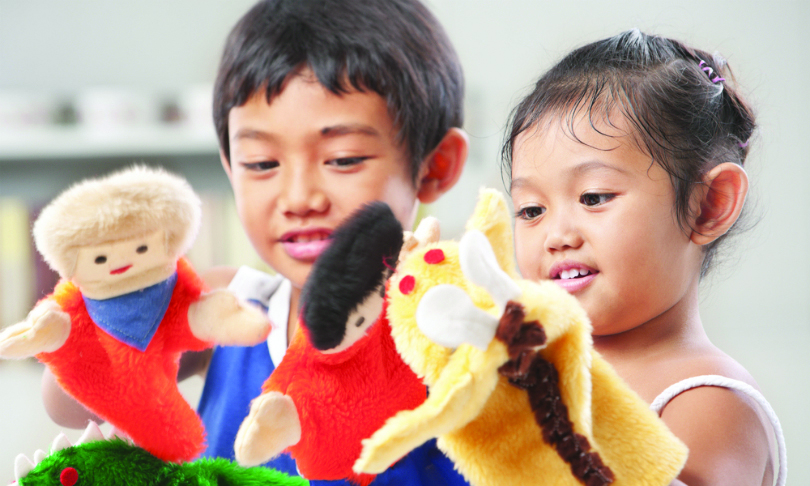
OR


Usha Pokharel
Usha Pokharel is an educationist and author of several children’s books.usha@pokharel.net
In Greece and Rome, upon reaching puberty boys dedicated their toys to the Gods and girls dedicated their toys to Goddesses when they married
The other day during a casual conversation with a relative I found out his daughter, a seventh grader, was into dollmaking. I was pleasantly surprised. I could not fathom what was more interesting to her, the dolls themselves or the process of making them. For a while, I wondered what a doll symbolized to her. If you think about it, you will find yourself thinking in the same line. Historically we find that many people associate dolls with different things. Many people associate dolls with fertility: it could symbolize a desire to have children or fear of having children. For some others, dolls symbolize a desire to be a child again. For me, it is pure joy of entertainment. Just the thought of dolls takes me back to my early childhood.
My first doll was a Japanese one: a very sweet-looking one with long hair. It had long blond hair. I still remember it had detachable hands and feet and head. I was very small at the time, about five years old. I remember it being bought in Delhi. My mom even made a sweater for the doll. We had accompanied my father on his official visit there. I saw this doll in the display window of a store and fell in love with it instantly. It was my favorite. My doll traveled with me wherever I went. A few months later we had to leave Nepal for Calcutta (Kolkata). Then after some time, we went to live in a village in Assam, my maternal uncle’s home.
The home was full of my cousin brothers and sisters. As usual, everyone wanted to play with it. The doll had to endure a lot of pulling and shoving. Then there was curiosity factor. One day the doll was broken. I think that is where I lost it. Next, I had a doll that closed its eyes when laid down to sleep. That too was a fun doll. When that doll was lost, my mother made rag dolls for me. They were wonderful. I still remember the dolls made out of my mother’s old saris. They had long black hair made of black yarn, used by women to plait their hair and stick hands. They wore saris just like my mother, grandmother or any other adult women.
Life with dolls became very real for us. We organized different festivities that we witnessed in the society around them, including a marriage ceremony for the dolls and shared our khaja as a marriage feast. This reminds me of a small interaction with Sushila kaki (BP Koirala’s wife) a long time ago while in Banaras. She once told me about the time when everyone from the Koirala family was in jail in Biratnagar. Having both parents in jail, children would move freely from one jail to another visiting their parents. They would even have doll marriages held. The groom’s Janti traveled from one jail to another jail to meet his bride as part of the doll’s marriage. It must have been a small spark of joy to the parents to see their children enjoying themselves despite the adverse situation.
History of dolls
Do dolls even have a history? They do.
Yes, dolls have a very rich history. They were traditionally used in magic and religious rituals around the world. They were made of clay and wood in the Americas, Asia, Africa, and Europe. The earliest documentation of dolls dates back to the ancient civilizations of Egypt, Greece, and Rome. The earliest dolls were made from available materials: clay, stone wood, bone, ivory, leather, or wax. Archaeological evidences place dolls as the oldest known toy. Wooden paddle dolls were found in Egyptian tombs as early as the 21st century BC. Dolls with movable limbs and removable clothing date back to at least 200 BC. Archaeologists discovered Greek dolls made of clay with movable hips and shoulders. Around 100 AD in ancient Greece, girls played with dolls. In Rome, graves of children contained dolls dressed according to the latest fashion. Traditionally in Greece and Rome, upon reaching puberty boys dedicated their toys to the Gods and girls dedicated their toys to Goddesses when they married. You will be surprised to know that Roman rag dolls date back to 300 BC. They were traditionally homemade with scrapes of cloth available at home. Traditionally dolls were used as children’s play objects but sometimes they were also used for spiritual, magical and other rituals purposes.
In Africa, dolls were used to teach and entertain children. At the same time dolls were also used as supernatural intermediaries often manipulated for ritual purposes. Some other cultures considered dolls too laden with magical powers and hence did not allow children to play with them. In some African cultures, dolls are often passed down from mother to daughter. Japan also has a very rich history of dolls. Japanese dolls date back to the Dogu figures (8000–200 BC) and Haniwa funerary figures (300–600 AD). By the eleventh century, dolls were used as playthings as well as for protection and in religious ceremonies.
In Iran during Qajar era (1909-1925), people criticized the politics and social conditions of Ahmad-Shah’s reign through puppetry without any fear of punishment. According to the Islamic rules, the act of women dancing in public is a taboo, but dolls or puppets have free and independent identities. Hence, they can do what is not feasible for the real person thus allowing ordinary people to state through puppets and dolls, what is impossible in the real situation.
Russia’s traditional Matryoshka dolls are a set of hollow wooden figures that nest inside each other. In Germany, clay dolls have existed as early as the 13th century, and then in the 15th century wooden doll came into existence. Dolls with detailed features and wearing fashionable clothes but crudely constructed bodies were first sold in France as early as the 16th century. During the same time, German and Dutch peg wooden dolls became popular with the poor children in Europe because they were cheap and simple. Wood remained the dominant material for making dolls until the 19th century in Europe. In the 20th century, polymer and plastic materials were used in doll making. At the same time, soft vinyl became the dominant material, in making children’s dolls. Although these materials were dominant in commercial doll making, cloth dolls did not lose their charm and have existed for almost as long as cloth itself.
Dolls were made of cloth in ancient Egypt and rag dolls have been made ever since. They have been more popular in some periods of history than others, but they have never been forgotten. The main reason for this is that cloth is the easiest of all materials for a woman to find. A mother could always use at least an old rag to fashion a doll for her child. Besides it being readily available, cloth is easy to work with and requires practically no tools. The basic simplicity and charm of rag dolls sets them apart from other dolls. From a child’s point of view even though most rag dolls lack sophistication and realism, none other feels as good as a rag doll.
Hold their imagination
Parents need to understand that toys do not need to be expensive. They need to engage the child over a while. They should be simple but also creative enough to hold your child’s imagination. Of course, it would be wonderful if parents could find some time to play with them. When parents participate, their children’s learning is enhanced. I can understand your dilemma, you do not have time. In the evening you come in tired after work and are in no mood to play with them. Have you tried spending time with your children when you are tired? It refreshes and relaxes you. Why not give it a try? Who knows, you might just surprise yourself.
Pokharel is an educationist and author of several children’s books
usha@pokharel.net
You May Like This

Pussycat Dolls announce reunion tour 10 years after split
The Pussycat Dolls are reforming for a reunion tour kicking off in Dublin next year, the American girl band said... Read More...

Things to know about PAN
KATHMANDU, July 28: The government has made Personal Account Number (PAN) mandatory for all salaried workers from the current Fiscal Year... Read More...

The importance of dreams
Sharada Rijal, owner of Milan Garments, United Nepal Felt Industries, and Lalit Handicrafts, says she always dreamt of having her... Read More...






Just In
- Fake Bhutanese refugee case: SC orders continued pre-trial detention for seven individuals including former DPM Rayamajhi
- ADB Vice-President Yang pays courtesy call on PM Dahal
- PM Dahal, Chairman of CIDCA Zhaohui hold meeting
- MoFAGA transfers 8 under secretaries and 11 section officers (with list)
- PM Dahal arrives in Morang
- DDC pays Rs 480 million dues to farmers
- Police arrest seven Indian nationals with 1.5 kg gold and Rs 14.3 million cash
- Gold price increases by Rs 1,400 today












Leave A Comment